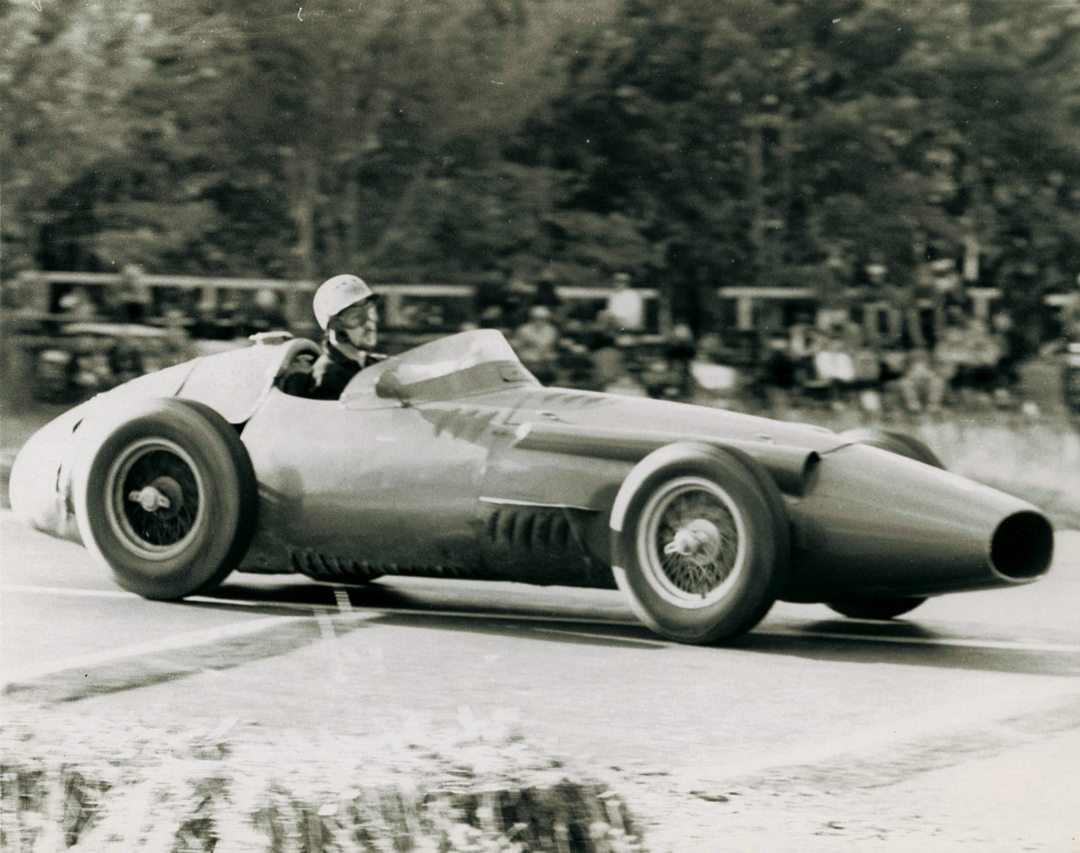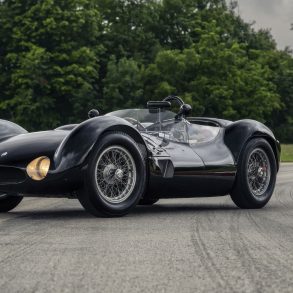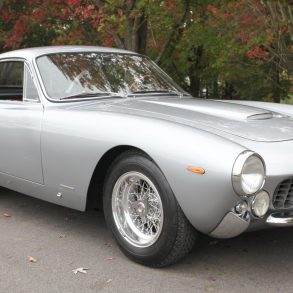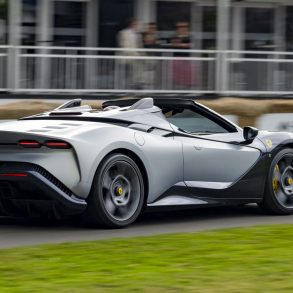Fluent in six languages, tall, with regular features set off by an immaculately clipped goatee beard and moustache, Jo Bonnier crammed a lot into his 42 years. He was an accomplished Formula One and sports car racer, president of the Grand Prix Drivers Association and proprietor of his own art gallery. But he never quite hit the big time, although winning the Targa Florio twice and a Grand Prix was not far off the mark.
Born into a wealthy family with its own publishing business called Bonnier Aktiebolag in Stockholm, Sweden, on January 31, 1930, Jo was educated in the Swedish capital, Paris and Oxford, but rejected the business life. He yearned to break loose and race. So he started with an old Harley-Davidson motorcycle when he was 17, then went rallying and ice racing. Before settling for a motor racing career, he became an officer in the Swedish navy and saw service on destroyers.
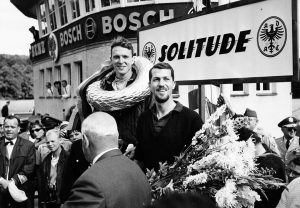
After that, Jo graduated to sports cars and first competed in an Alfa Romeo Disco Volante before his first Formula One race in the 1956 Italian Grand Prix at Monza. He shared a rather tired Maserati 250F with 47-year-old Gigi Villoresi, but the car expired after seven laps. Bonnier continued in 1957 with a Scuderia Centro Sud 250F and came a reasonable 7th in the Argentinean GP, followed by a handful of retirements. He ran his own 250F for most of 1958 and drove that into 2nd places at both Syracuse and Caen. Those performances caught the eye of BRM, which were struggling to make its engines competitive on the newly stipulated aviation fuel, and he was given a two-year contract. Jo showed the team was on the right road when he took 4th in the last GP of the season at the Ain Diab circuit near Casablanca, Morocco, which was no walkover as he was up against the GP cream, including winner Stirling Moss and, thanks to Stirling’s sense of fair play, new World Champion Mike Hawthorn.
The BRM P52s had brake problems at Monaco, so they went off to Zandvoort with Moss to do some extensive testing a week before the 1959 Grand Prix of Holland on May 31. Gradually, the great Englishman honed the brakes and car into a contender on the Dutch circuit, then went back to his usual Rob Walker Cooper-Climax, while Bonnier and Harry Schell took their BRMs back. Blustery weather conditions on the Dutch coast meant lap times were down, but come Saturday evening who should be sitting on pole but Joakim Bonnier! He led from the outset, but was overtaken by a hard-charging Masten Gregory in a Cooper-Climax and that began a nose-to-tail pursuit by the Swede until the American’s car began to jump out of gear, so Jo overtook him on lap 12 and led the race comfortably for a while. But Stirling and Jack Brabham were making up ground in their Cooper-Climaxes and alternated in the lead. Then Jack Brabham’s gearbox started giving the same erratic performance and Bonnier overtook him. Moss caught Brabham on lap 46 and by the 60th Stirling was right on Jo’s tail, He slipped past the Swede and it seemed it was all over—until Stirling came crawling into the pits three laps later with an equally uncooperative gearbox, and stayed there. Bonnier led for the remaining 12 laps to cross the finish line the winner of his one and only Grand Prix at an average speed of 93.48 mph.
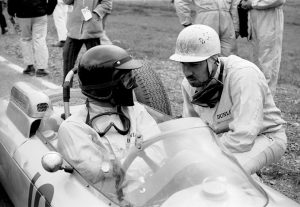
Photo: Porsche
Jo did best in sports racers, though. He signed for Porsche for 1959 and immediately started to bring in the results. Like 3rd in the 12 Hours of Sebring, the year’s first round of the World Sports Car Championship, and 2nd in the last counter, RAC Tourist Trophy at Goodwood in a 718 RSK—shared in both races with Wolfgang von Trips. A year later, he scored the first of his Targa Florio wins with Hans Herrmann in a 718 RS60: he was the fastest in practice and put in the quickest lap of the race with a mighty 42 minutes and 46 seconds over the 44.739-mile circuit. He took another second in the ADAC 1000 Kilometers at the Nürburgring a couple of weeks later, this time with Belgian Olivier Gendebien in an RS60, and helped Porsche into 2nd place behind Ferrari in the championship.
The Porsche 718 RSK was also converted into Formula 2 single-seaters and re-designated 787, which pulled off an astonishing 1-2-3 at Britain’s Aintree circuit driven by Moss, Bonnier and Graham Hill, respectively. Amid the squalls and glowering black clouds of the Eifel mountains, Jo pulled off a courageous win for Porsche in the German Grand Prix, which had been downgraded by the locals to a Formula 2 event and run on the south loop of the Nürburgring.
There was more of the same in 1961, when Jo and Dan Gurney came 2nd in the Targa driving a Porsche 718 RS61, and Bonnier got 1962 off to a good start with victory in the 12 Hours of Sebring driving a Ferrari 250TR with Lucien Bianchi, then a convincing 3rd in the 1962 Sicilian event with local star Nino Vaccarella driving a 718 GTR. Better was to come in 1963, when Jo won his second Targa Florio with Carlo Maria Abate in a Porsche 718 GTR, the car’s agility a major advantage in the wet, slippery conditions that did almost as much to defeat the challenging Ferraris as the German cars.
Jo also came close to winning the 1964 24 Hours of Le Mans with his old pal Graham Hill in a Ferrari 330P, where they took a fine 2nd place. The two did win the year’s 12 Hours of Reims together in a Ferrari 250 LM, and in early October they scored again with a win in the 1000 Km of Paris at the Montlhéry circuit in a Ferrari 330P.
After a dismal 1965 driving Brabham-Climaxes, Jo ran his own Cooper-Maserati for a couple of seasons from 1966, then competed in a string of other cars including a McLaren-BRM, Honda, Lotus 63 and a McLaren M5A-Cosworth without much to show for his efforts. The M5A literally ended up hanging on a wall in Bonnier’s house as a little home decoration.
Jo became more interested in other activities, like his art gallery in Lausanne, and was the first GP driver to take up residence in Switzerland for fiscal reasons. Together with Jackie Stewart, Bonnier was also a major driving force behind the GPDA, which was formed in 1961; he became its first vice-president and then president, fighting for greater safety in motor racing.
Meanwhile, Bonnier came 2nd with Herbert Müller of Switzerland in the Austrian GP for sports cars driving a Lola T70-Chevrolet, and won the 1970 European 2-Liter Sports Car Championship in a Lola T210-Ford. The following year he won the 1000 Km of Barcelona with fellow Swede Ronnie Peterson in a Lola T212, and took 3rd once more in the Targa Florio in the car, co-driven by Dickie Attwood.
It all ended, however, at about 8 a.m. one foggy Sunday morning during the 1972 24 Hours of Le Mans. Bonnier was overtaking a slower Ferrari, but clipped the Italian car. The Lola flew off the track, threw Jo to his death and exploded on impact with the ground.


